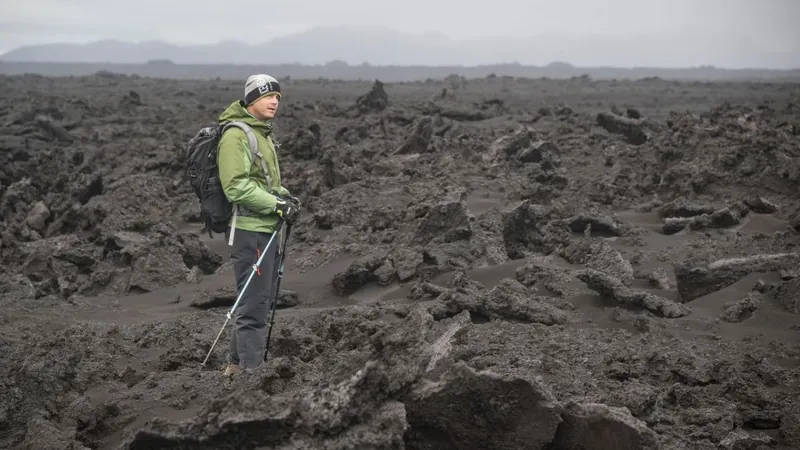
From Apollo to Artemis: Unveiling Iceland’s Secret Role in NASA’s Lunar Missions
2024-10-09
Author: Mei
This summer, six aspiring astronauts trekked through a stark, lifeless landscape of black and grey sediment that resembled the lunar surface more than Iceland's picturesque beauty. This isolated terrain is, in fact, Iceland’s Vatnajökull National Park, where NASA hosted its latest astronaut training mission.
As part of the Artemis II mission, NASA and Canadian Space Agency (CSA) astronauts collaborated with geologists to gather volcanic rock samples, hone navigational skills, and scout potential training sites for future lunar endeavors. The U.S. space agency aims to return humans to the Moon by the end of the decade, marking the first crewed landing since the historic Apollo missions of the 1960s and ’70s.
Iceland, a small island nation nestled on the fringes of Europe, is set to play an instrumental role in preparing astronauts for the Moon, just as it did during the Apollo era.
A Terrain Like No Other
The geology of the Moon has layers similar to Earth, featuring a metallic core, a 1,350 km thick lunar mantle, and about 50 km of crust. The Moon’s surface is marked by large basins, known as maria, where volcanic activity created basalt rock formations. Vatnajökull National Park shares many of these characteristics, with its craters and basalt formations mirroring those found on the lunar surface, as noted by chief park ranger Helga Hvanndal Björnsdóttir.
Björnsdóttir observed the astronauts' excitement about the desolation of Iceland's landscape, remarking, “It’s like living in space.” The unique terrain allows astronauts to study breccia—angular rock fragments that bond together—further enhancing their geological training.
To reach their training site, the astronauts load supplies into off-road vehicles and embark on a six-hour journey from Reykjavik to the park. Due to prolonged snowpack, the park is only accessible for about three months a year, making NASA's intensive training missions a critical part of a short, vibrant research season.
Despite this unique opportunity, many Icelandic citizens and visitors remain unaware of NASA's astronaut training programs taking place in their own backyard.
A Rich History of Training
Since the 1960s, Iceland has been a chosen location for astronaut training. Orlygur Hnefill Örlygsson, founder of the Exploration Museum in Húsavík, noted this lesser-known aspect of Iceland's contribution to space exploration. Originally, NASA's Apollo astronauts struggled to stay engaged with geology classes—often catching Z's during lectures. Recognizing the need for a more hands-on approach, NASA initiated field trips to Iceland, a decision that would leave a lasting legacy.
During expeditions in 1965 and 1967, more than 30 astronauts explored areas around Lake Mývatn and Askja within Vatnajökull National Park, learning to analyze the Moon's geological features firsthand.
Trevor Graff, exploration geologist at NASA’s Johnson Space Center, confirmed that today’s astronauts employ the same techniques used during the Apollo missions, utilizing standard geological tools to understand the terrain they will encounter on the Moon.
The Artemis II Mission Ahead
The astronauts training in Iceland this summer are gearing up for Artemis II, a pivotal step in NASA's mission to return humans to the Moon. This monumental mission will see four astronauts spending ten days in orbit, with aspirations to travel approximately 7,400 kilometers beyond the lunar far side.
Their spacecraft, Orion, is designed to pave the way for future lunar landings, including the anticipated Artemis III mission, which aims to touch down near the Moon's South Pole. Although Artemis II will not involve a landing, the training conducted in Iceland will be vital for the astronauts’ upcoming scientific research, including a detailed study of lunar craters from orbit.
NASA has ambitious goals with these missions, stating, “Artemis II will pave the way to land the first woman, first person of color, and first international partner astronaut on the Moon.” Scheduled for launch in September 2025, Artemis II serves as a precursor to the groundbreaking Artemis III mission set for 2026.
As NASA gears up to repeat history, Iceland stands ready to play a pivotal role once again, transforming its otherworldly landscape into a launchpad for humanity's next giant leap. Don't miss out—this could be the start of a new era in space exploration!

 Brasil (PT)
Brasil (PT)
 Canada (EN)
Canada (EN)
 Chile (ES)
Chile (ES)
 España (ES)
España (ES)
 France (FR)
France (FR)
 Hong Kong (EN)
Hong Kong (EN)
 Italia (IT)
Italia (IT)
 日本 (JA)
日本 (JA)
 Magyarország (HU)
Magyarország (HU)
 Norge (NO)
Norge (NO)
 Polska (PL)
Polska (PL)
 Schweiz (DE)
Schweiz (DE)
 Singapore (EN)
Singapore (EN)
 Sverige (SV)
Sverige (SV)
 Suomi (FI)
Suomi (FI)
 Türkiye (TR)
Türkiye (TR)